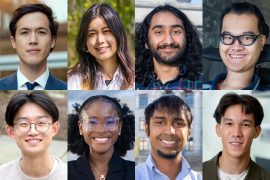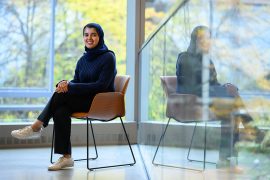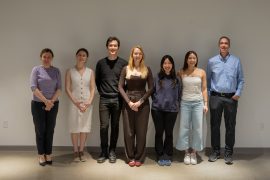A microcosm of research

MIT undergraduates are using computing to tackle critical research questions, delving into fields as diverse as robotics, health care, and transportation through the Advanced Undergraduate Research Opportunities Program (SuperUROP).
A yearlong research experience supported by coursework, SuperUROP is an expanded version of MIT’s Undergraduate Research Opportunities Program. SuperUROP was launched by the Department of Electrical Engineering and Computer Science and quickly expanded across the School of Engineering. Thanks to philanthropic support, it also now brings together projects in the School of Humanities, Arts, and Social Sciences with computer science.
“SuperUROP has evolved into a microcosm that showcases the research taking place around the Institute,” says Ted Equi ’81, SM ’84, former SuperUROP industrial sponsor liaison. Equi, who is now the MIT Leaders for Global Operations director of academics, research, and career engagement, noted that 102 students enrolled in the advanced program this year. Here are project examples from this year’s class.
Space Exploration
Jaeyoung Jung ’21, Texas Instruments Undergraduate Research and Innovation Scholar
Project title: Gallium-Nitride Complementary MOS Microprocessor for High-Temperature Applications
Advisors: Tomás A. Palacios, professor, Department of Electrical Engineering and Computer Science (EECS), with PhD student Nadim Chowdhury SM ’18
Silicon-based electronics have transformed life on Earth, but they are ill-suited to the demands of space. This project’s goal is to equip computers for a trip to Venus, where surface temperatures can reach 471ºC (880ºF). Semiconductors made with gallium nitride (GaN) rather than silicon can function at temperatures as high as 1,000ºC. However, GaN circuits typically consume too much power to be used practically in microprocessors. Nadim Chowdhury, working with Tomás A. Palacios, has developed a new transistor that addresses this issue, work that could prove critical in deploying electronics in harsh environments.
An electrical engineering major, Jaeyoung Jung is working with Chowdhury and Palacios on the next step: designing the world’s first energy-efficient GaN microprocessor. “This work will allow for sophisticated computing systems in spacecraft,” says Jung, who uses industry-standard software for semiconductor device analysis and circuit design.
“If everything goes well, we expect Jaeyoung to start fabricating the GaN microprocessor at the new MIT.nano cleanroom facility in early 2020,” says Palacios. The team hopes the microprocessor will be used to control a rover on a future NASA trip to Venus. “The SuperUROP program has allowed us to try a moon shot kind of project — in fact, a Venus-shot — and have an amazing MIT undergraduate student at the center of it.”
Robotics
Ashay Athalye ’20, Angle Undergraduate Research and Innovation Scholar
Project Title: Sensor Fusion of Visual and Tactile Sensory Data for Object Localization and Robotic Manipulation
Advisors: Alberto Rodriguez, associate professor, Department of Mechanical Engineering (MechE), with MechE PhD student Maria Bauza SM ’18
Like humans, robots need to perceive and understand their environment to manage tasks. Unlike humans, robots still can’t easily and reliably track moving objects. Ashay Athalye’s project combines visual and sensory data to assist a robotic arm in better estimating object location.
Currently, many robots employ deep-learning algorithms such as Deep Object Pose Estimation (DOPE), which uses images to estimate object position. However, DOPE doesn’t consider information about where the object was previously or how it might be moving. Athalye, who is majoring in EECS with minors in mechanical engineering and economics, is endeavoring to incorporate such information by applying probabilistic filtering to the output of such algorithms, a method that has shown promise in preliminary testing.
“His work builds from state-of-the-art techniques based on deep learning to estimate the pose of objects under occlusions and fuse them with classic techniques for filtering that aim at providing smoother and temporally coherent object tracking,” says advisor Alberto Rodriguez. “The particular approach involves adding a probabilistic interpretation to outputs of a deep neural network, which then can be used as measures of confidence to do robust object tracking.”
Next, Athalye plans to apply similar filtering techniques to tactile data drawn from robot sensors. His goal is to effectively combine tactile and visual information to help robots with manipulation tasks.
“This project, which involves inference, machine learning, and control theory, has been a perfect way to apply what I’ve learned in my classes,” Athalye says.
Transportation
Avital Vainberg ’21, Undergraduate Research and Innovation Scholar
Project Title: Visualizing Spatiotemporal-Activity Travel Patterns
Advisors: Joseph Ferreira Jr. ’67, EE ’70, SM ’70, PhD ’71, professor, Department of Urban Studies and Planning (DUSP) with DUSP PhD student Rounaq Basu MCP ’19, SM ’19
Location-tagged data are widely available but often underutilized by urban planners and policy makers. Avital Vainberg is working to put such data to better use by developing visualizations that are accessible to nontechnical audiences.
Vainberg, who is majoring in urban science and planning with computer science, and minoring in theater arts, is using travel survey data from Singapore to develop an interactive dashboard. “The goal is to inform planners and policy makers of where, when, and why people are traveling in order to encourage better decisions regarding land use, zoning, and transportation infrastructure.”
Advisor Joseph Ferreira Jr. says, “Avital is focusing on a data-processing pipeline that isolates and parallelizes the computing-intensive image generation steps so that the activity patterns of subgroups can be visualized and compared on the fly from an interactive dashboard.”
For example, Vainberg has created an animation that maps the activity patterns of Singapore’s residents, revealing commuting habits and other trends. Her dashboard will enable users to filter the data by such criteria as demographics and time of day.
Ferreira says that these visualizations can reveal patterns that could otherwise be hard to detect, such as activity clusters that might signal a need for additional transportation.
“This project has simultaneously sharpened my coding and data science skills, pushed me to think critically of the world around me, and encouraged me to take on impactful projects,” Vainberg says.
Computer Systems
Amir Farhat ’20, Hewlett Foundation Undergraduate Research and Innovation Scholar
Project Title: Understanding the Fundamentals of Reconfigurable Data Center Networks
Advisor: Manya Ghobadi, TIBCO Career Development Assistant Professor, Department of Electrical Engineering and Computer Science; Computer Science and Artificial Intelligence Laboratory
The explosion of data in every field from health care to business has spurred growing demand for big data analytics. This has led to increased use of big data server farms, where up to a million servers work together to tackle complex computations and run large applications such as web search engines.
A computer science and engineering major, Amir Farhat is endeavoring to make large-scale data centers more efficient by changing the physical topology of a wired data center network to increase its throughput. The goal is to develop a “smart” data center.
“By engineering the network to be reconfigurable to adapt to demand, we hope to increase the application performance in large-scale data centers,” he says.
In traditional data center networks, operators decide in advance how much capacity to provide. Farhat is developing a simulation framework to experiment with alternative data center architectures and scheduling algorithms in the hopes of designing a reconfigurable data center.
“It might seem impossible to change the topology of a network without physically changing the cables,” says advisor Manya Ghobadi. But she says optical networking, which encodes information in light waves, opens the door to new design options. Since optical waves can be redirected using mirrors, they are capable of quick changes: no rewiring required.
“This is a realm where the network is no longer a static entity but a dynamic structure of interconnections that may change depending on the workload,” Ghobadi says, noting that Farhat is helping to lay the groundwork for the future. “This work promises to revolutionize the way networks are designed in practice, defined in textbooks, and taught in classrooms.”
This article originally appeared in the Spring 2020 issue of MIT Spectrum magazine.


